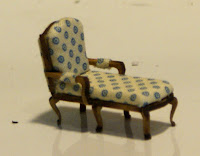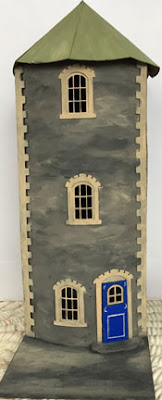It always amazes people how easy it is to do quarter scale kits.
Every show there is always someone who looks at my kits and says "oh I love them but I can't work that small."
Then the next year they come back and say "My friend convinced me that I have to try one."
And then the next show they are there with a list saying " I'm hooked!! This much easier than I thought and it all fits in such a small area."
I feel like the Quarter Pusher . 'Psst want to buy a kit?" LOL
But the fact remains it is easy to do quarter scale. Sometimes, surprisingly easy.
One of the best tools are tweezers. You can hold kit parts, dip them in glue and position the parts all in the same move. You can set your chair in place and move it around with tweezers and then you can add a tiny throw cushion on the chair with the tweezers. Try doing that with 1/12!
Staining the kit pieces is very simple too. Use a touch up stain pen. Most hardware stores now carry marking pens with stain that match their larger cans. Or you can use an alcohol based coloured marker if you would like a blue chair or a faded green cabinet. The all the pens will let the grain of the wood show through. If the kit pieces are in a panel then stain the entire panel of pieces before you take separate them. Much easier. remember to do both sides.
If you are painting the piece then do that after it is assembled as the paint is less likely to warp the wood if it is glued together.
 Paint brushes don't have to be 10/0 to paint something quarter scale but they do help sometimes. Another standby is a round toothpick. Once the base coat is on you can add an amazing number of designs with the pointed end of a toothpick dipped in paint. Dots, of course, but also tiny commas and fine lines. Those 3 things can be combined to add gold decorations, flowers, scrolls and almost any other detail you can imagine.
Paint brushes don't have to be 10/0 to paint something quarter scale but they do help sometimes. Another standby is a round toothpick. Once the base coat is on you can add an amazing number of designs with the pointed end of a toothpick dipped in paint. Dots, of course, but also tiny commas and fine lines. Those 3 things can be combined to add gold decorations, flowers, scrolls and almost any other detail you can imagine. Most pieces are held in the panel with tiny uncut tabs. Use a sharp craft knife to cut the tab. Press with the knife on the tab and it should POP. If it doesn't turn the piece over and press again.
Don't try to slide the knife along the tab to cut it. That can slip and cut into the piece or tear the wood.
My #1 rule is use wood glue on wood. You can add a touch of tacky to help it hold quickly but please don't use tacky to build furniture. I know a lot of people say the opposite but Tacky is meant to stay flexible. Chair legs that bend away from the seat won't hold up your little people and are very frustrating to the carpenter.
I have found a new glue called wood glue MAX that works like a tacky glue and sets solidly.
For upholstery, tacky works just fine. The tackier the better. I love The Ultimate by Crafter's Pick. Unfortunately it is getting harder to find but well worth the search. It also works well for holding the furniture in the room. Just a dot on one or two chair legs will hold it in place on the carpet or flooring.
As far as fabric goes, always use natural fabric. No polyester or anything wrinkle free. That is meant to stay flat and is horrible to try to glue on anything small. Cotton or silk will let you drape it and glue with a lot less fighting.
 Paper fabric is rather fun to do too. Try this; Print a quilt on regular paper with your printer. Cut it out and then roll it up as if you were making a spit ball. Remember them. I know you 'never' did that is school but I'm sure you saw one once. Un roll your spit ball' and then crumple it up again. Do it a coupe of times until the paper is soft and a but limp. Don't go too far or the printing will wear off. Now you have a nice soft quilt that can be draped and folded to lay over the end of a chair or bed and will have the soft look of fabric.
Paper fabric is rather fun to do too. Try this; Print a quilt on regular paper with your printer. Cut it out and then roll it up as if you were making a spit ball. Remember them. I know you 'never' did that is school but I'm sure you saw one once. Un roll your spit ball' and then crumple it up again. Do it a coupe of times until the paper is soft and a but limp. Don't go too far or the printing will wear off. Now you have a nice soft quilt that can be draped and folded to lay over the end of a chair or bed and will have the soft look of fabric. That's it for now. if you need any help with a technique send me an email and I will try to help.
There is a complete list of my kits in a pdf file on th lft of the home page on m website.
www.petworthminiatures.com
and the photo gallery there also has photos of rooms and settings with lots of decorating ideas.










